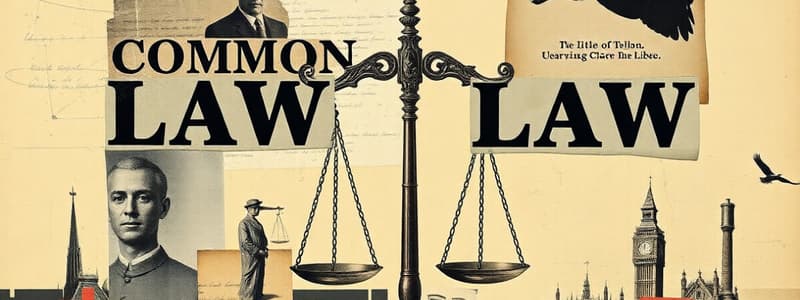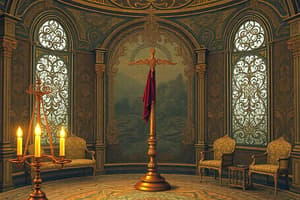Podcast
Questions and Answers
What is a primary source of law in Common Law systems?
What is a primary source of law in Common Law systems?
- Judicial precedents (correct)
- Codified regulations
- Legislative acts
- Statutory law
Judicial precedents in Civil Law systems are legally binding.
Judicial precedents in Civil Law systems are legally binding.
False (B)
What does the term 'stare decisis' refer to?
What does the term 'stare decisis' refer to?
The doctrine of using judicial precedents to guide decisions in court cases.
Judicial precedents are considered a valuable legal source in __________ Law systems.
Judicial precedents are considered a valuable legal source in __________ Law systems.
Match the following aspects with the appropriate legal system:
Match the following aspects with the appropriate legal system:
Which of the following best describes the role of judges in Civil Law systems?
Which of the following best describes the role of judges in Civil Law systems?
Judges in Common Law systems are appointed by elected officials.
Judges in Common Law systems are appointed by elected officials.
According to Montesquieu, how are courts described in Civil Law systems?
According to Montesquieu, how are courts described in Civil Law systems?
Which of the following systems does the United States use for appointing Supreme Court judges?
Which of the following systems does the United States use for appointing Supreme Court judges?
Judges in the United States serve for fixed terms and have age limits.
Judges in the United States serve for fixed terms and have age limits.
What is the term length for judges appointed in Germany's system?
What is the term length for judges appointed in Germany's system?
In Germany, the Federal Constitutional Court is made up of ______ judges.
In Germany, the Federal Constitutional Court is made up of ______ judges.
Match the country with its judge appointment system:
Match the country with its judge appointment system:
Which factors must be considered by the U.S. President when appointing a Supreme Court judge?
Which factors must be considered by the U.S. President when appointing a Supreme Court judge?
The mixed-system of appointing judges can lead to quick and efficient appointments.
The mixed-system of appointing judges can lead to quick and efficient appointments.
What type of system does Italy use for appointing constitutional judges?
What type of system does Italy use for appointing constitutional judges?
In a mixed-system, democratic accountability is maintained through the participation of ______.
In a mixed-system, democratic accountability is maintained through the participation of ______.
Which of the following is a disadvantage of a mixed-system for appointing judges?
Which of the following is a disadvantage of a mixed-system for appointing judges?
In Austria, the Federal Government and Parliament participate in the appointment of judges.
In Austria, the Federal Government and Parliament participate in the appointment of judges.
Who officially appoints judges in Germany after they are elected?
Who officially appoints judges in Germany after they are elected?
The political element of judicial nominations in the U.S. arises primarily from the ______ system.
The political element of judicial nominations in the U.S. arises primarily from the ______ system.
Match the type of appointment system to its description:
Match the type of appointment system to its description:
What is a key aspect of the Common Law system?
What is a key aspect of the Common Law system?
Flashcards
Common Law
Common Law
A legal system where judicial precedents (past rulings) from higher courts are a primary source of law. Judges interpret precedents to decide cases, establishing new precedents in the process.
Civil Law
Civil Law
A legal system where written laws (statutes, codes) are the primary source of law. Judges interpret these laws, but they cannot create or change them.
Judicial Precedent
Judicial Precedent
A previous court ruling that serves as a binding precedent for similar cases.
Stare Decisis
Stare Decisis
Signup and view all the flashcards
Judges in Civil Law
Judges in Civil Law
Signup and view all the flashcards
Judges in Common Law
Judges in Common Law
Signup and view all the flashcards
Binding Precedents
Binding Precedents
Signup and view all the flashcards
Appointment of Judges in Common Law
Appointment of Judges in Common Law
Signup and view all the flashcards
Appointment-Based System
Appointment-Based System
Signup and view all the flashcards
Election-Based System
Election-Based System
Signup and view all the flashcards
Mixed-System
Mixed-System
Signup and view all the flashcards
Merit-Based Selection
Merit-Based Selection
Signup and view all the flashcards
Common Law System
Common Law System
Signup and view all the flashcards
Civil Law System
Civil Law System
Signup and view all the flashcards
Political Orientation
Political Orientation
Signup and view all the flashcards
Non-discrimination
Non-discrimination
Signup and view all the flashcards
Senate Confirmation
Senate Confirmation
Signup and view all the flashcards
Supreme Court
Supreme Court
Signup and view all the flashcards
Federal Constitutional Court
Federal Constitutional Court
Signup and view all the flashcards
Fixed Term Appointments
Fixed Term Appointments
Signup and view all the flashcards
Lifetime Appointments
Lifetime Appointments
Signup and view all the flashcards
Mixed-System
Mixed-System
Signup and view all the flashcards
Judicial Independence
Judicial Independence
Signup and view all the flashcards
Study Notes
Common Law vs. Civil Law Systems
- Common Law systems rely on judicial precedents (stare decisis) for legal rulings, viewing them as binding precedents from prior cases, especially higher courts.
- Civil Law systems prioritize codified regulations, statutory law, and legislative acts as primary legal sources, emphasizing legal theory.
- Judges in Common Law systems are active in shaping legal principles and precedents, playing a role in societal adaptation. Appointments often use elected officials.
- Judges in Civil Law systems are interpreters of existing law, focused on legal theory and codified laws. Appointments often involve public examinations.
Role of Judges in Different Systems
- Common Law judges, like in the UK, are vital for applying and interpreting precedents. Their decisions establish new legal precedents and adapt to societal norms. Often directly or indirectly appointed by elected officials.
- Civil Law judges, inspired by Montesquieu's view, are considered the "mouth of the law" interpreting existing laws. Appointments based on legal theory often involve public exams.
Constitutional Judge Appointment Systems
- Appointment systems vary across countries.
- Appointment-based: The executive (e.g., President) appoints judges with legislative input (e.g., Senate confirmation). Example: United States.
- Election-based: The legislature elects or significantly influences judge appointment. Example: Germany.
- Mixed-system: Combines elements of both appointment and election. Example: Italy.
- Mixed-systems balance diverse perspectives and democratic accountability but can be complex and slow. Issues like deadlock are possible.
- US presidential appointment prioritizes legal expertise and (often assumed) political alignment without formally considering it, contrasted to Germany's legislature-led elections based method.
- Mixed systems like Italy involve multiple branches creating potential for delays and disputes.
US Appointment System (Example)
- US Supreme Court judges appointed by the President, confirmed by the Senate.
- Criteria for nomination include legal expertise but often involve political considerations.
- Lifetime appointments grant significant influence to the President.
Germany Appointment System (Example)
- German Constitutional Court judges are elected by the legislature (Bundestag & Bundesrat).
- Judges serve fixed terms and have age limits.
- Emphasizes expertise in legal theory, reflected in public examination processes.
Mixed System Example (Italy)
- Judges appointed through a combined process involving the executive, legislature, and judiciary which creates a balancing mechanism but can produce delays.
- Multiple bodies involve creating more bureaucracy but may be beneficial in diverse selections.
- Italy's example highlights potential for gridlock in the appointment processes which can hinder judicial court function.
Studying That Suits You
Use AI to generate personalized quizzes and flashcards to suit your learning preferences.




